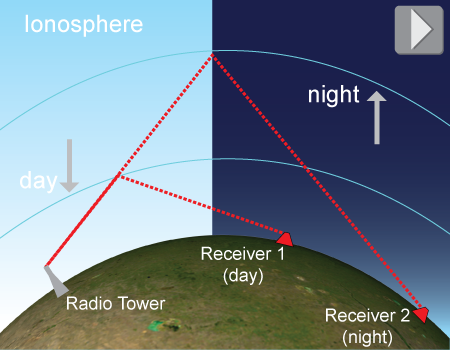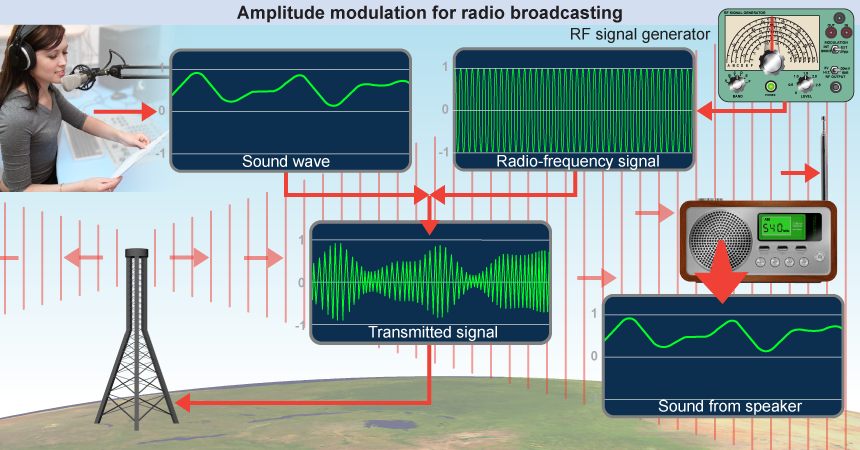|
 Until recently, people could only hear each other as far as they could shout—across a canyon or village, perhaps. Now, though, you can talk with a friend halfway around the globe as if she were next door. We owe this amazing state of affairs to electromagnetic radiation, which travels through air at 300,000 kilometers per second—roughly 10 million times as fast as highway traffic. At this speed, light, radio waves, and other forms of EM radiation can circle the globe 7½ times each second. (Indeed, they can reach the Moon in a heartbeat and the planet Mars in a matter of minutes.)
Until recently, people could only hear each other as far as they could shout—across a canyon or village, perhaps. Now, though, you can talk with a friend halfway around the globe as if she were next door. We owe this amazing state of affairs to electromagnetic radiation, which travels through air at 300,000 kilometers per second—roughly 10 million times as fast as highway traffic. At this speed, light, radio waves, and other forms of EM radiation can circle the globe 7½ times each second. (Indeed, they can reach the Moon in a heartbeat and the planet Mars in a matter of minutes.) 
|
As you learned on page 650, EM radiation has a dual personality: It can act like a wiggling wave or like a particle smashing abruptly into matter. Ocean-crossing conversation originally focused on the wave nature of EM radiation. In 1902, inventor Guglielmo Marconi transmitted a simple coded message from North America to Europe. Marconi had built a machine that pushed electrons up and down along a metal wire. These electrons were accelerated tens or hundreds of thousands of times per second (tens or hundreds of kilohertz, or kHz), and this generated radio waves a kilometer or more in length. Shortly thereafter, speech and music were broadcast using radio waves, which has impacted society ever since. 
|
How did this process work? First, a radio station’s microphone “heard” an audible tone and turned it into an electrical signal. (It could do this because sound waves pushed back and forth on a magnet within the microphone, and this generated a vibrating current within a coil of thin wire.) Next, a special circuit mixed this audio-frequency signal with the higher frequency radio waves that the station used to reach its listeners. This constantly changed the amplitude of those radio waves, making them strong when sound was loud and weak when it was quiet. Amplitude modulation (AM)—a technology that remains in widespread use—was born. 
 |
 AM radio stations can extend their reach because the Earth’s upper atmosphere reflects radio waves. This electrically charged upper layer, the ionosphere, is lowest by day, when the Sun energizes it. After sunset, the ionosphere rises and radio waves can be reflected to much more distant receivers. If you have found yourself able to tune into a neighboring state’s AM radio stations by night, you have personally taken advantage of this ionospheric version of total internal reflection! Astronomers use radio-wave reflections to study flares and explosions on the Sun. They can do this because solar activity can energize the ionosphere, pushing the reflecting layer down to unusually low elevations.
AM radio stations can extend their reach because the Earth’s upper atmosphere reflects radio waves. This electrically charged upper layer, the ionosphere, is lowest by day, when the Sun energizes it. After sunset, the ionosphere rises and radio waves can be reflected to much more distant receivers. If you have found yourself able to tune into a neighboring state’s AM radio stations by night, you have personally taken advantage of this ionospheric version of total internal reflection! Astronomers use radio-wave reflections to study flares and explosions on the Sun. They can do this because solar activity can energize the ionosphere, pushing the reflecting layer down to unusually low elevations. 
|

|
Suppose your favorite AM radio station broadcasts at a frequency of 560 kHz. Which of the following is closest in size to the wavelength of the radio waves being transmitted by this station? - an ant
- a rattlesnake
- a helicopter
- an aircraft carrier
 |
The correct answer is d.
Asked: object that is closest in size to the wavelength (λ) of the given wave
Given: station frequency f = 560 kHz
Relationships: c = fλ; speed of light c = 3×108 m/s; 1 kHz = 103 Hz
Solve:
Rearrange and solve equation for λ: The wavelength is 536 m; this is closest in size to the length of an aircraft carrier. 
|
Frequency modulation (FM) is another technology for using radio waves to convey sound information. Instead of varying the amplitude of the transmitted wave, FM varies its frequency, albeit by a relatively tiny amount (by less than 1%). When the frequency of an FM station’s signal increases, what happens to its wavelength? - It increases.
- It decreases.
- It remains unchanged.
- It is doubled.
 |
The correct answer is b. Frequency and wavelength are inversely related by the equation c = fλ. 
|
| |
|

